

Etruscan Necropolises of Cerveteri and Tarquinia. Etruscan Necropolises of Cerveteri and Tarquinia These two large Etruscan cemeteries reflect different types of burial practices from the 9th to the 1st century BC, and bear witness to the achievements of Etruscan culture.
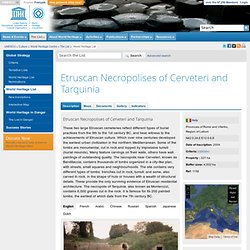
Which over nine centuries developed the earliest urban civilization in the northern Mediterranean. Some of the tombs are monumental, cut in rock and topped by impressive tumuli (burial mounds). Many feature carvings on their walls, others have wall paintings of outstanding quality. The necropolis near Cerveteri, known as Banditaccia, contains thousands of tombs organized in a city-like plan, with streets, small squares and neighbourhoods. Nécropoles étrusques de Cerveteri et de Tarquinia Ces deux grandes nécropoles étrusques reflètent divers types de pratiques funéraires entre le IXe et le Ier siècle avant J.C. et comptent parmi les plus beaux témoignages du monde étrusque, cette civilisation urbaine du nord de la Méditerranée. المقابر الأترورية في تشيرفيتيري وتاركينيا. The Museum of Roman Ships at Fiumicino. An accidental discovery delivered this unique collection.
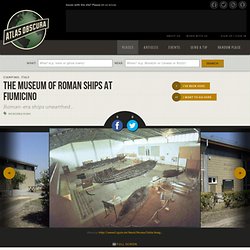
In the early 50s when the Italian government began excavating for a new airport, they stumbled upon an ancient port built by Emperor Claudius in 46 C.E. An archeologist's dream: they found boats, entire hulls of Roman freighters and a fishing boat. These ships provide a precise glance into everyday life of ancient maritime Rome. These large vessels carried 1,500 tons of grain. Lake of Nemi.
Lake Nemi is a volcanic lake that lies between Nemi and Genzano of Rome, in the territory of the Roman Castles and covers about 1.60 square kilometers.
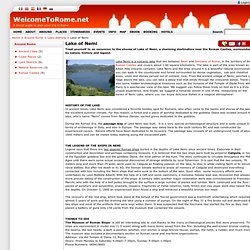
The lake is part of the area known as the Alban Hills volcanic complex. Lake Nemi and the area around it is a beautiful natural environment: you can walk in the countryside and forest surrounded by dense vegetation, oak and chestnut trees, vines and stones carved out of volcanic rock. The National Archaeological Museum of Palestrina. Roman Monographs - Aqueducts · part II - how Roman aqueducts worked. The aqueducts collected water from several natural springs, located far away from the city (the farthest source was that of the Anio Novus, 87 Km or 59 Roman miles east of Rome).
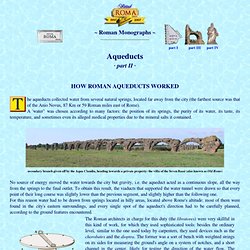
A 'water" was chosen according to many factors: the position of its springs, the purity of its water, its taste, its temperature, and sometimes even its alleged medical properties due to the mineral salts it contained. Appia Antica Park - English version - Official Siteweb. Why bother to visit the Colosseum? OK it's one of the most memorable buildings in Rome -- indeed in Western culture.

And the reason I co-wrote a book on it, is that I truly believe that its history from ancient gladiatorial arena to 19th century botanical garden is more fascinating than most people realise. It looks absolutely tremendous from the outside. But is it really worth a couple of hours queuing to see the very battered ruins of the interior? I'm not so sure. I have just been in Rome for a few days, doing a recce for a new little tv series on ancient Rome (from the point of view of ordinary Romans, not the emperors and generals etc). Rome's Appian Way: The Perfect Springtime Stroll. What better way to celebrate spring—and Easter (you know, "quo vadis" and all that) —than a stroll on the ancient Appian Way?
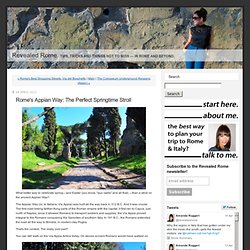
The Appian Way (or, to Italians, Via Appia) was built all the way back in 312 B.C. And it was crucial. The first road linking farther-flung parts of the Roman empire with the capital, it first ran to Capua, just north of Naples; since it allowed Romans to transport soldiers and supplies, the Via Appia proved integral to the Romans conquering the Samnites of southern Italy. In 191 B.C., the Romans extended the road all the way to Brindisi, in modern-day Puglia. That's the context. You can still walk on the Via Appia Antica today.
Or even take a bike ride. Visiting The Appian Way (Via Appia Antica) From Rome Independently Or By Tour Bus. Author: Bob Handford Official Web Site - Via Appia Antica The Via Appia Antica is the old Roman Appian Way, which ran from Rome down to Brindisi.
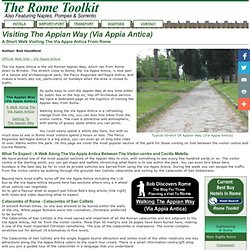
The stretch close to Rome, the Via Appia Antica, is now part of a nature and archaeological park, the Parco Regionale dell'Appia Antica, and makes a lovely day out, particularly on Sundays when the area is closed to traffic. Its quite easy to visit the Appian Way at any time either by public bus or the hop on, hop off Archeobus service. Catacombs of priscilla. Le Domus Romane di Palazzo Valentini.